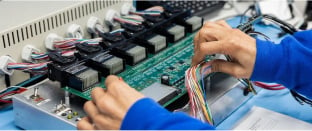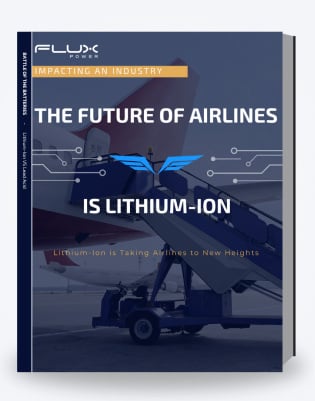As the adoption of lithium-ion battery solutions continues to grow across various sectors, it's essential to consider their lifecycle and the implications for sustainability. With many batteries reaching their end-of-life phase, there is an urgent need for battery manufacturers and operations using material handling equipment to plan for the next steps. This includes focusing on effective battery recycling processes and exploring potential second-life applications for these batteries.
The Lithium Battery Recycling Process
When lithium-ion batteries reach their end-of-life, recycling becomes a critical process to recover valuable materials and reduce environmental impact. The recycling process typically involves several steps:
- Collection and Transportation: Used lithium batteries are collected and safely transported to recycling facilities.
- Disassembly: Batteries are manually dismantled, and hazardous components are removed.
- Crushing and Shredding: The batteries are then crushed and shredded to break them down into smaller pieces.
- Hydrometallurgical Process: This involves using chemical solutions to leach out valuable metals like lithium, cobalt, and nickel.
- Solid/Liquid Separation: After leaching, solid and liquid materials are separated using techniques such as filtration or centrifugation.
- Precipitation and Purification: Valuable metals are precipitated from the solution and purified for reuse.
These recovered materials, particularly lithium, cobalt, and nickel, can be reused to manufacture new batteries or used in other industries, such as glass and ceramics manufacturing, further conserving natural resources and reducing the need to extract new raw materials.
Second-Life Applications for Lithium-ion Batteries
Beyond recycling, there is significant potential for reusing lithium-ion batteries in second-life applications. Once a battery's capacity for its original purpose diminishes, it can still be suitable for less demanding applications. Here are some potential uses:
- Energy Storage Systems: Repurposed lithium-ion batteries can be effectively utilized in stationary energy storage systems, such as those used for electric vehicle charging stations and residential or commercial energy storage. These systems store excess power during low demand and release it during peak times, aiding in the management of energy costs and enhancing the efficiency of renewable energy integration. This not only extends the useful life of the batteries but also supports a more sustainable energy landscape by maximizing the utilization of renewable resources.
- Backup Power: In critical settings like hospitals and data centers, repurposed lithium-ion batteries are essential for maintaining power continuity. They store energy securely to ensure it is readily available during power outages, bolstering operational continuity and enhancing safety.
- Light Electric Vehicles: E-bikes and electric scooters benefit from the strategic reuse of lithium-ion batteries, offering a sustainable alternative by extending the lifespan of these power cells. These less demanding applications can utilize batteries that no longer meet the performance criteria for vehicles but are still capable of providing adequate service. This practice not only helps reduce waste but also supports eco-friendly transportation options.
These second-life uses can extend the lifecycle of the batteries, defer the environmental impact of manufacturing new batteries, and provide economical storage solutions.
Environmental Impacts
By recovering valuable materials and extending the lifecycle of lithium-ion batteries, industries can mitigate the costs associated with raw material procurement and waste management.
- Reduction in Greenhouse Gas Emissions: Extracting and processing raw materials typically consume a lot of energy and result in significant emissions of greenhouse gases. By recycling used batteries, the need for these processes is diminished, directly reducing the carbon footprint associated with production.
- Waste Reduction and Landfill Avoidance: Batteries contain hazardous substances that can leach into the environment if disposed of in landfills. Recycling and repurposing batteries not only divert these from landfills but also minimize the environmental contamination risks. Proper handling and processing of battery components ensure hazardous materials are safely managed and neutralized.
- Conservation of Natural Resources: Recycling lessens the demand for new raw materials, thereby conserving scarce natural resources. By reducing the need for fresh material extraction, recycling also helps preserve ecosystems and biodiversity.
- Energy Efficiency: It is often more energy-efficient to recycle materials than to extract and refine new ones. The energy savings associated with using recycled materials instead of virgin resources can be substantial, contributing to a decrease in overall energy consumption in the manufacturing sector.
Taking Charge: Our Collective Responsibility
Lithium battery cycle life management is an essential facet of modern energy systems. As our reliance on these technologies grows, it becomes imperative for battery manufacturers and operations involved in material handling to take responsibility and begin planning for the future. This planning must prioritize establishing effective recycling processes that recover valuable materials and reduce environmental burdens.
Furthermore, developing second-life applications for batteries not only optimizes resource utilization but also enhances energy management. These strategies are critical not just for advancing sustainable practices within the battery industry but also for promoting a circular economy and minimizing the ecological footprint of our technological dependence. It is our collective responsibility to ensure that the end-of-life phase of batteries is managed with foresight and innovation, setting a standard for sustainability that impacts various industries.












